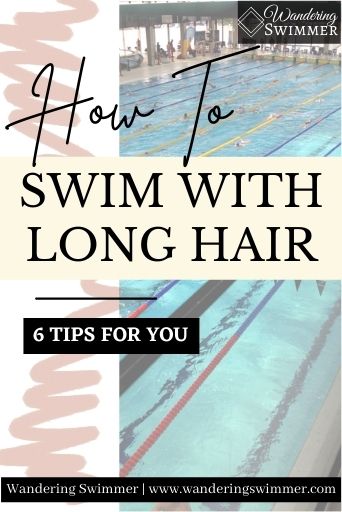One common swimming question we get asked frequently is “can you swim with long hair?’
And our resounding answer is always ‘yes, you can swim with long hair’. Whether that’s learning how to swim, having fun at the pool, getting in a workout, or swimming competitively.
Still aren’t convinced or have some questions? Here are 6 tips to help you swim with long hair and protect it.
Disclosure: This post may contain affiliate links, meaning we earn a small commission at no cost to you if you purchase something through one of our links. As an Amazon Associate, we earn from qualifying purchases. Please check out our disclosure page for more information.

Can You Swim with Long Hair?
100% yes! You can swim with long hair.
It may take a bit more time when it comes to pulling your hair back or washing it after getting in the water. But that shouldn’t deter you from enjoying your time at the pool.
Just as it shouldn’t keep you from considering being a competitive swimmer!
A lot of people think they need to cut their hair short to swim. But truthfully, you can swim with any length of hair.
And if anyone tries to say otherwise, you can remind them almost every female Olympic swimmer has long hair. If they can do it, so can you!
We’ll also note that men can swim with long hair too. 🙂 Long hair can apply to anyone!
6 Tips for Long Haired Swimmers
If you’re planning on swimming with long hair, we have some tips for you to make things a bit easier. From how to protect your hair to the best hairstyles to wear, we’ve got you covered!
1. How to Protect Your Hair While Swimming
Wear a Swim Cap
The best way to protect your hair (long or short) when in the pool is to wear a swim cap.
Swim caps help form a barrier against the chlorine and chemicals in the pool. Or the salt if you’re at the beach.
Related article: 6 Reasons Why You Should Wear a Swim Cap
They can also help protect your hair from UV rays from the sun. Which can bleach or lighten your hair.
Wearing a swim cap when you swim also keeps your hair out of your face. And out of the pool.
What are the best swim caps if you have long hair? Keep reading to find out. Or you can check out our article here if you want to know now 😉
Wet Your Hair
If you can, wet your hair with clean water completely before going swimming. Whether you wear a cap or not when you swim. This can help prevent chlorine from drying out your hair too much.
How? Glad you asked!
Your hair absorbs water. And by wetting it before you get in the pool, it’s already absorbed all the liquid it can hold. This makes it more difficult for your hair to soak in the chemicals at the pool.
Admittedly, some chemicals will still get in your hair. But the amount will be far less than if you jumped in with dry hair.
Lastly, be sure to rinse your hair with clean water after you get out of the pool. The sooner the better to help prevent the chlorine from settling in.
Before Swim Care for Long Hair
You can treat your hair before getting in the water to help protect it from chlorine. However, you need to do this well before your swim so your hair can absorb the product. And it doesn’t wash out into the pool.
You’ll also want to ensure the product you’re using won’t make your swim cap too slippery so that it falls off. Otherwise, you’ve defeated the purpose of both products!
One before swim hair care product we recommend is AquaGuard from Underwater Audio (who also makes great waterproof headphones and MP3 players).
You should wet your hair first before applying. Then allow at least 5-10 minutes for the product to absorb properly. This can help prevent chlorine or salt damage, and protect your hair color.
Be sure to rinse it out well after your swim and follow up with hair products to remove chlorine or salt. This will keep your hair looking and feeling healthy.

2. Swim Cap Options for Long Hair
One of the biggest challenges in swimming for individuals with long hair is getting it all into a swim cap!
The good news though, is that they now make swim caps specifically for long hair. These caps are just a bit larger than your standard ones, making it easier to fit all your hair.
When looking for long hair swim caps, you’ll want to ensure the cap is made from silicone. Silicone caps stretch easier than latex. And they’re less likely to rip when putting them on.
Certain swim caps from Sporti, Speedo, and TYR are made specifically for long hair.
Some brands, such as Dsane and Lahtak make extra-large swim caps designed for dreadlocks, afros, box braids, and more.
Check out our full review on the Best Swim Caps for Long Hair for a complete breakdown!
3. How to Put Long Hair in a Swim Cap
This truly comes down to a personal choice. Most of which is based on what feels comfortable for you, what works for you, and your hair type.
We’ve found that the easiest option for most is to put your hair into a bun and then put on your swim cap. Based on your preference and hairstyle, you can put the bun high or low.
You can also braid your hair and then circle it up into a bun. Or just leave as a single braid and wear your cap.
For those that can’t pull their hair back, it is possible to put a cap on if your hair is down or loose.
Regardless of the hairstyle you wear, one of the simplest ways to put on a swim cap by yourself is to follow the below steps:
- With the opening facing down, put both hands into the cap on the left and right sides. Be sure to watch your nails!
- Bring the cap up to your forehead
- Place the opening of the cap on your forehead with your palms facing your head
- Stretch the cap back and over your head
- You may need to adjust the cap some once it’s on and tuck in any loose strands
If you can, ask someone for help!
4. Best Hairstyles for Swimming with Long Hair
If you decide to forgo a swim cap while swimming, you’ll want to put it up in some type of hairstyle.
Long hair can become especially tangled and knotted in the pool. And the chlorine can make any knots extremely difficult to get out.
Because of this, it’s better to swim with your hair up instead of down.
Some great hairstyle options to wear at the pool or beach are:
- Bun: This will keep your hair pulled back and collected into one place. It’s our personal go-to for swimming with and without a cap!
- Ponytail: Pull your hair back into a ponytail to keep it out of your face. If you find that your hair still tangles and knots in a ponytail (which it may), you might want to braid the ponytail
- Pigtails: We like pigtails because it separates your hair into smaller sections, making it less likely to tangle. Wear them high or low
- Braids: Braids can be a bit tricky when water is involved. They hold up well when you’re swimming but can be difficult to undo when you’re done swimming.
5. After Swim Care for Long Hair
Taking care of your hair before getting into the water is important. But it’s equally as important that you take care of your hair after getting out of the water.
For both short and long hair!
Whether you swim with or without a cap, you’ll want to ensure that you rinsing out your hair with clean water. This helps remove any chemicals or salt in your hair and keeps them from building up.
We also recommend that you wash your hair before you attempt to style or dry your hair.
Attempting to dry or straighten your hair while it still has chlorine or salt in it can damage the strands. Leaving them dry and brittle.
If you can’t wash your hair after a swim, do your best to rinse out your hair and towel it dry. You can also spray some leave-in treatment if it works for your hair type. Brush it out and then put it up.
Ask any swimmer with long hair and they’ll tell you the best hairstyle right after a swim is a messy bun!
6. Best Swim Shampoo and Conditioners for Swimmers
We always recommend washing your hair after an outing to the pool, lake/river, or beach. Especially if you didn’t wear a swim cap.
Doing so can keep your hair clean and healthy, and leave you feeling great! Conditioners especially will help keep your hair soft and tangle-free once you’re out of the pool.
Most shampoos and conditioners on the market will suffice if you’re not in the pool frequently. Although you may want to work in some leave-in conditioner or a hair mask if you’re concerned about dry hair
Related article: The 7 Best Swim Shampoos to Remove Chlorine
However, whether you’re a frequent swimmer or you want your hair looking its best, you may want to invest in specific swimming hair products.
These are designed specifically to help remove the pool chemicals or salt from your hair. And make your hair look fantastic afterward!
Some good hair products to consider are:
- TRISWIM: TRISWIM makes ‘chlorine out’ shampoo and conditioners. They’re designed to help clean and moisturize your hair after a swim. Keeping your hair strong and healthy! You can also check out their body wash and lotions, too.
- MalibuC: Malibu C offers several varieties of hair products. But they have a set geared specifically for swimmers. We recommend their Swimmers Wellness Set for those that have blonde hair. It’s ideal for helping remove the green tint you may develop.
- UltraSwim: UltraSwim helps remove the buildup of chlorine from your hair and keeps your hair soft. Use both their shampoo and conditioner for best results.
In Closing
Can you swim with long hair? The answer (in our opinion) is a resounding yes. It may take a little more effort before and after your swim. But you shouldn’t let that stop you from enjoying your time at the pool or beach. 🙂
Bonus Content
What Equipment Do You Need to Start Lap Swimming? What swim equipment do you need to start swimming? We help you break down which gear you need so you can make the best decision
How to Pick the Right Swim Goggles: When it comes time to pick the right swim goggles, you might feel overwhelmed. Consider these 4 things the next time you’re looking at goggles.

Want to Improve at the Pool?
Join swimmers and swim parents to receive my free newsletter and receive a free Swimming Glossary e-book as a thanks!
Every month you’ll receive tips and coaching to help you find success at the pool.
About

Chevron is a current competitive swimmer with almost 20 years of experience in the pool. And although she fell into the sport by accident in her high school years, she still trains daily and competes throughout the year. She’s committed to providing guidance to all levels of swimmers and believes that everyone should know how to swim.